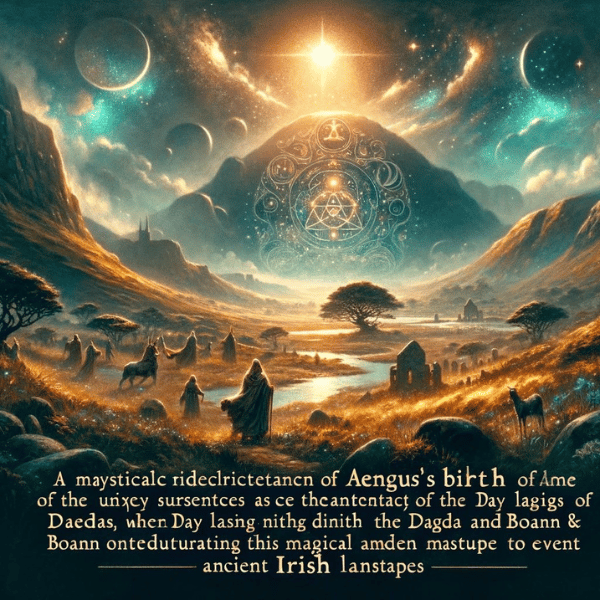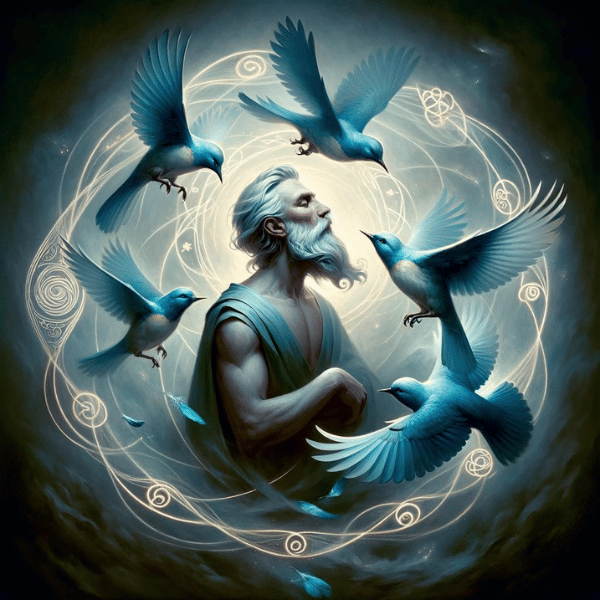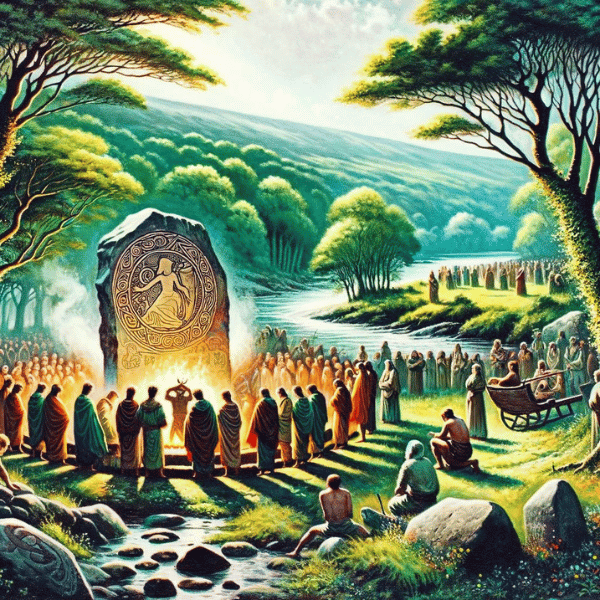Aengus, often celebrated as the Irish god of love, beauty, and youth, occupies a central role in the pantheon of Irish mythology. Known for his youthful charm and unwavering ability to inspire love and passion, Aengus’s tales are woven into the fabric of Irish folklore, embodying themes of desire, eloquence, and the pursuit of that which is often just out of reach. Despite common misconceptions, Aengus does not hail from Norse mythology but rather from the ancient and mystical traditions of the Irish, as a distinguished member of the Tuatha Dé Danann, the mythological race said to have inhabited Ireland before the arrival of humans. This clarification is crucial for understanding the unique cultural context and heritage from which Aengus’s stories emerge, highlighting the importance of distinguishing between the rich tapestries of mythologies that enrich our world’s history.
| Attribute | Aengus Information |
|---|---|
| Origin | Irish Mythology |
| Deity Type | God of Love, Youth, and Poetic Inspiration |
| Role | God associated with love, youthfulness, beauty, and poetic inspiration |
| Brugh na Bóinne | Known for his association with Brugh na Bóinne, a sacred site associated with the Boyne Valley |
| Swan Transform | Famed for his association with the story of “The Dream of Aengus,” where he transformed into a swan |
| Cultural Impact | A significant figure in Irish mythology, symbolizing love, beauty, and artistic inspiration |
| Depictions | Featured in Irish folklore and myths, often depicted as a handsome and youthful deity |
1. Early Life and Origins
Birth and Unique Circumstances
Aengus’s entrance into Irish mythology highlights the mystical nature of his existence. The Dagda, chief deity of the Tuatha Dé Danann, and Boann, goddess of the River Boyne, conceived him in secrecy. The Dagda halted the sun’s movement for nine months, enabling Aengus’s birth in a single day to conceal their affair from Boann’s husband, Nechtan.
Parentage and Influence on His Powers
The lineage of Aengus, being the offspring of The Dagda and Boann, imbued him with remarkable abilities and a distinguished place among the deities of Irish mythology. From The Dagda, Aengus inherited strength, wisdom, and the ability to govern over life and death, elements that would play a pivotal role in his mythological narratives. Boann’s influence, representing the fluidity and transformative power of water, contributed to Aengus’s association with love, beauty, and poetic inspiration. This divine parentage positioned Aengus uniquely within the Tuatha Dé Danann, allowing him to navigate the complexities of the mythological world with grace and eloquence, often employing cunning and charm to achieve his desires. His origins not only highlight the interconnectedness of the Irish deities but also underscore the significance of lineage and legacy within the ancient myths, shaping Aengus’s role and powers in profound ways.

2. Aengus’s Role and Symbolism
Domains of Influence
Aengus, often revered as the god of love, beauty, and youth, plays a pivotal role in Irish mythology, embodying the quintessence of desire and aesthetic allure. His narratives are rich with themes of passionate pursuit, the enchantment of love, and the eternal allure of youthfulness. Aengus’s influence extends beyond the mere concept of romantic love to encompass a broader spectrum of beauty and inspiration, often acting as a muse for poets and artists, guiding them in their creative endeavors. His association with youth is not only a testament to his eternal vitality and vigor but also symbolizes the perennial renewal of life, hope, and possibility.

Symbols and Attributes
Aengus’s symbolism, rich and profound, resonates through recurring motifs in his myths. The swan, epitomizing transformation and beauty, reflects his role in guiding love’s journey. Stories tell of Aengus transforming into a swan for love, showcasing love’s transformative power. Often depicted with a harp, symbolizing harmony and enchantment, Aengus embodies music’s seductive allure. Through these symbols, his mythology imparts insights into love, beauty, and human nature, echoing timeless values.
3. The Four Birds of Aengus
The Myth of the Four Birds
One of the most enchanting aspects of Aengus’s mythology is the tale of the four birds that perpetually accompany him, emanating from his own kisses. These birds are not mere companions; they are potent symbols of love, protection, and the enchanting power of Aengus’s presence. According to legend, these birds possess the ability to charm and soothe all who hear their melodious songs, casting a spell of peace and serenity that mirrors Aengus’s dominion over love and harmony. Their presence underscores Aengus’s protective nature, offering a shield of comfort and safety to those under his gaze, and emphasizing his role as a guardian of love and beauty in the Irish mythological canon.
Symbolism and Significance
The four birds symbolize various aspects of love and protection, each bird representing a different facet of Aengus’s influence. Their enchanting songs embody the irresistible allure of love, capable of touching the hearts of all beings, transcending the boundaries between the mortal and the divine. This imagery reflects the multifaceted nature of love itself—its capacity to heal, inspire, and protect, as well as its inherent beauty and grace.
In Irish folklore, birds are often seen as messengers between worlds, bridging the gap between the earthly realm and the divine. The association of these birds with Aengus elevates his status as a deity who can traverse these boundaries, facilitating communication and interaction between the two worlds. Furthermore, the birds’ ability to cast a protective and soothing spell aligns with Aengus’s role as a deity of love, who not only incites passion but also offers solace and protection to those under his care.
4. Cultural Impact and Worship
Worship and Reverence in Ancient Ireland
Aengus, as a deity embodying love, beauty, and youth, held a special place in the hearts and rituals of ancient Ireland. The Irish people deeply connected with the land and its magic, intertwining worship of Aengus with natural cycles. They conducted rituals at sacred sites to honor him and seek favor. These sites, often associated with natural beauty and the presence of water, symbolized Aengus’s nurturing and life-giving aspects. The rituals performed in his name aimed to invoke his blessings of love and prosperity, highlighting his significance not only as a god of personal desire but also as a protector of the community’s wellbeing.

Influence on Modern Irish Culture
In modern times, Aengus’s influence permeates various facets of Irish culture, from literature and art to contemporary pagan practices. His myths, rich with symbolism and deep emotional resonance, continue to inspire poets, writers, and artists, serving as a wellspring of creativity and exploration. The figure of Aengus, with his eternal youth and passionate pursuit of love, embodies the spirit of romanticism and the enduring search for beauty in the world. His stories, particularly those involving quests for love and the overcoming of obstacles, resonate with contemporary themes of love, loss, and the power of the human spirit.
Furthermore, Aengus’s legacy is evident in the celebration of Irish folklore and mythology, where his tales are revisited and retold, connecting new generations with the ancient traditions and beliefs of their ancestors. This connection fosters a sense of identity and continuity, reinforcing the cultural heritage and collective memory of the Irish people. In contemporary pagan and neo-druidic practices, Aengus is revered as a deity of love and youth, with rituals and ceremonies adapted to honor him in a modern context, demonstrating the adaptability and enduring relevance of his mythology.
5. Aengus in Comparative Mythology
Comparison with Other Deities of Love and Beauty
Aengus, the Irish god of love, beauty, and youth, shares several attributes with deities from other mythological traditions, highlighting universal themes that transcend cultural boundaries. In Greek and Roman mythology, Eros (Cupid) serves as a counterpart to Aengus, embodying the force of love and desire. Both deities wield the power to spark love in the hearts of gods and mortals alike, using their respective symbols—the arrow for Eros and the swan or musical instruments for Aengus—to convey their influence. However, while Eros’s role often emphasizes the capricious and unpredictable nature of love, Aengus’s mythology tends to focus more on the nurturing, protective aspects of love and the pursuit of harmony and fulfillment.
Freyja, a goddess from Norse mythology, also shares similarities with Aengus, particularly in their associations with beauty, fertility, and fine material possessions. Freyja’s chariot, drawn by cats, and her love for the beautiful and the precious mirror Aengus’s appreciation for beauty and his pursuit of love. Yet, Freyja’s warrior aspect and her domain over the afterlife realm of Fólkvangr introduce a dimension of power and sovereignty that is less emphasized in Aengus’s more romantic and poetic narratives.

Interconnectedness of European Mythologies
The comparative analysis of Aengus with deities like Eros/Cupid and Freyja reveals the interconnectedness of European mythologies, highlighting shared cultural values and human experiences. These deities, despite originating from different mythological traditions, reflect a common understanding of love, beauty, and youth as fundamental forces that shape human life and society. The recurring themes in their myths—such as the pursuit of love, the celebration of beauty, and the value of youthfulness—underscore the universal appeal of these concepts and their relevance across time and culture.
This interconnectedness also points to the exchange of ideas and beliefs among ancient cultures through trade, conquest, and storytelling. As myths traveled and transformed, they absorbed elements from different traditions, enriching the tapestry of European mythology and reflecting the shared human fascination with the mysteries of love, the allure of beauty, and the promise of eternal youth. Aengus, in his embodiment of these timeless themes, serves as a bridge between the ancient and the modern, inviting reflection on the enduring nature of these fundamental aspects of human experience.
6. Conclusion
In exploring the mythology of Aengus, the Irish god of love, beauty, and youth, we uncover a rich tapestry of tales that resonate with universal themes central to the human condition. Aengus’s narratives, characterized by his quest for love, his symbolic association with the swan and musical harmony, and his protective, nurturing nature, illustrate the depth of his influence in Irish mythology. His stories, echoing the pursuits of love and the appreciation of beauty, highlight the interconnectedness of European mythological traditions, revealing shared cultural values across diverse civilizations. Aengus’s enduring legacy in Irish cultural consciousness is a testament to the power of mythology to inspire, unite, and provide insight into the complexities of life and love. Through the ages, Aengus remains a symbol of the eternal search for beauty, love, and youth, embodying the spirit of Irish heritage and its lasting impact on the world.
